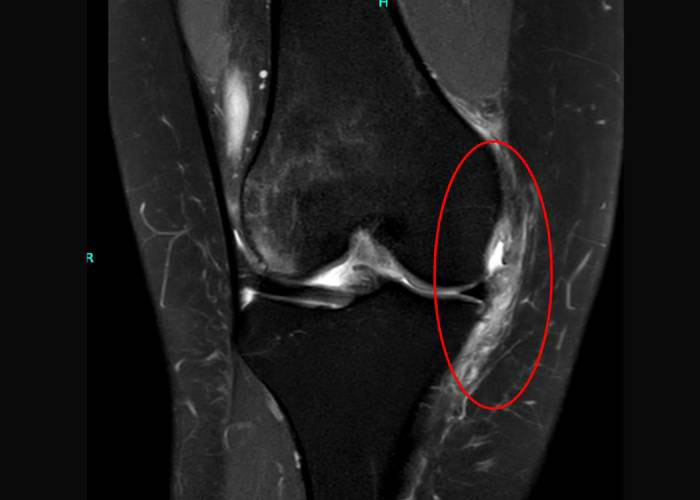MCL Injury Specialist
Do you have a sharp pain along the inside of your knee? Is it swollen and you can’t put any weight on the joint? You could have a medial collateral ligament (MCL) injury. MCL Injury specialist, Dr. Prem N. Ramkumar is located in Long Beach and treats patients from the Los Angeles, Orange County, and surrounding California areas in Los Angeles and Orange County California who are experiencing painful symptoms of an MCL injury. Contact Dr. Ramkumar’s team today!

What is an MCL injury?
The medial collateral ligament (MCL) is also one of the most commonly injured ligaments in the knee. The MCL is the ligament connecting the femur (thigh bone) to the tibia (shin bone) on the inner aspect of your knee, allowing you to bend, cut, and rotate your knee while keeping it stable. It has two points of fixation on the tibia and one on the femur, making it a complex structure warranting increased scrutiny. An MCL injury occurs when extreme force is placed on the outside of the knee joint, causing the MCL on the inside of the knee to stretch or tear. A direct blow to the knee or hyperextending the knee are two ways in which the MCL can be injured. It is not unusual for athletes to hurt both the MCL and the ACL simultaneously. Dr. Prem N. Ramkumar, orthopedic knee specialist, treats patients in Long Beach and from Los Angeles, Orange County, and surrounding California areas who are experiencing the symptoms of an MCL injury.


How did I injure my MCL?
Jumping incorrectly, changing direction while running, or a blow to the outside of the knee joint are some of the ways you could injure the MCL in your knee joint. Any motion that causes the knee to twist, like a car or bicycle accident, can cause an MCL injury. Athletes experience MCL strains, sprains, or injuries more often than those not involved in sports. The MCL is commonly injured at the time of a concomitant ACL injury.
What are the Symptoms of an MCL injury?
The most common symptom of an MCL injury is the sharp and sudden pain you will feel on the inner side of your knee. The pain usually comes with swelling, tenderness, buckling, and knee stiffness. Other common symptoms of an injury to the MCL may include:
- A “popping” sound when you hurt your knee
- Bruising around the knee
- A less stable range of motion in the knee
- Feeling as if the knee will buckle or give way
- Inability to bear weight on the knee joint
You may also report a “locking” or “catching” sensation when you move the injured knee joint. Sometimes, the signs of an MCL injury can be mistaken for a medial meniscus tear.
How is an MCL injury diagnosed?
In the office, Dr. Ramkumar will ask questions about how you injured your knee and where you are experiencing pain. He always performs a thorough physical examination of the knee to determine stability and strength. X-rays will be taken as an initial first step to evaluate the baseline status of your knee. A clinical exam and magnetic resonance imaging (MRI) scan are two of the best diagnostic tools to determine if you have an MCL injury and the treatment plan. The scan allows Dr. Ramkumar to review all the soft tissues in the knee and determine if there is any other damage to the knee joint that may contribute to your symptoms.
How is an MCL injury graded?
Dr. Ramkumar gives your MCL injury a “grade” to categorize its severity. Grade 1 is the least severe, while grade 3 is the most severe:
Grade 1: The ligament is stretched but not torn.
Grade 2: A partial tear of the MCL with some instability
Grade 3: A complete tear of the MCL with joint instability
What is the Best Treatment for an MCL injury?
Grade 1 and 2 MCL injuries are often treated non-surgically. In certain settings, even grade 3 MCL injuries can heal without surgery. Dr. Ramkumar most often recommends surgery if multiple ligaments in the knee are damaged.
Non-surgical treatments for an MCL sprain or partial tear include:
- A combination of rest, ice, compression, and elevation (RICE)
- NSAIDS (non-steroidal anti-inflammatories) to help manage swelling and pain
- Physical therapy to strengthen the muscle around the knee joint
- Bracing to stabilize the knee joint until the MCL heals
It could take up to 12 weeks for the ligament to heal using one or more non-surgical treatments.
If you completely tear your MCL or don’t respond to non-surgical treatments, surgery may be necessary to repair or reconstruct the ligament. In many cases, other soft tissue and ligaments must also be repaired.
Surgical treatments for an MCL tear include:
- MCL Repair
- MCL Reconstruction
Dr. Ramkumar favors a mini-open approach called an MCL repair – when the torn ligament is either sutured back together or sutured to the bone to promote healing. If the ligament isn’t reparable, Dr. Ramkumar may perform an MCL reconstruction, replacing the torn ligament with a graft. Two types of grafts are available:
- An allograft comes from a donor, often a cadaver ligament or tissue bank
- An autograft comes from the patient
Recovery time from surgery is typically 12 weeks if only the MCL is involved. Healing time may be longer if other ligaments and soft tissue are involved.

